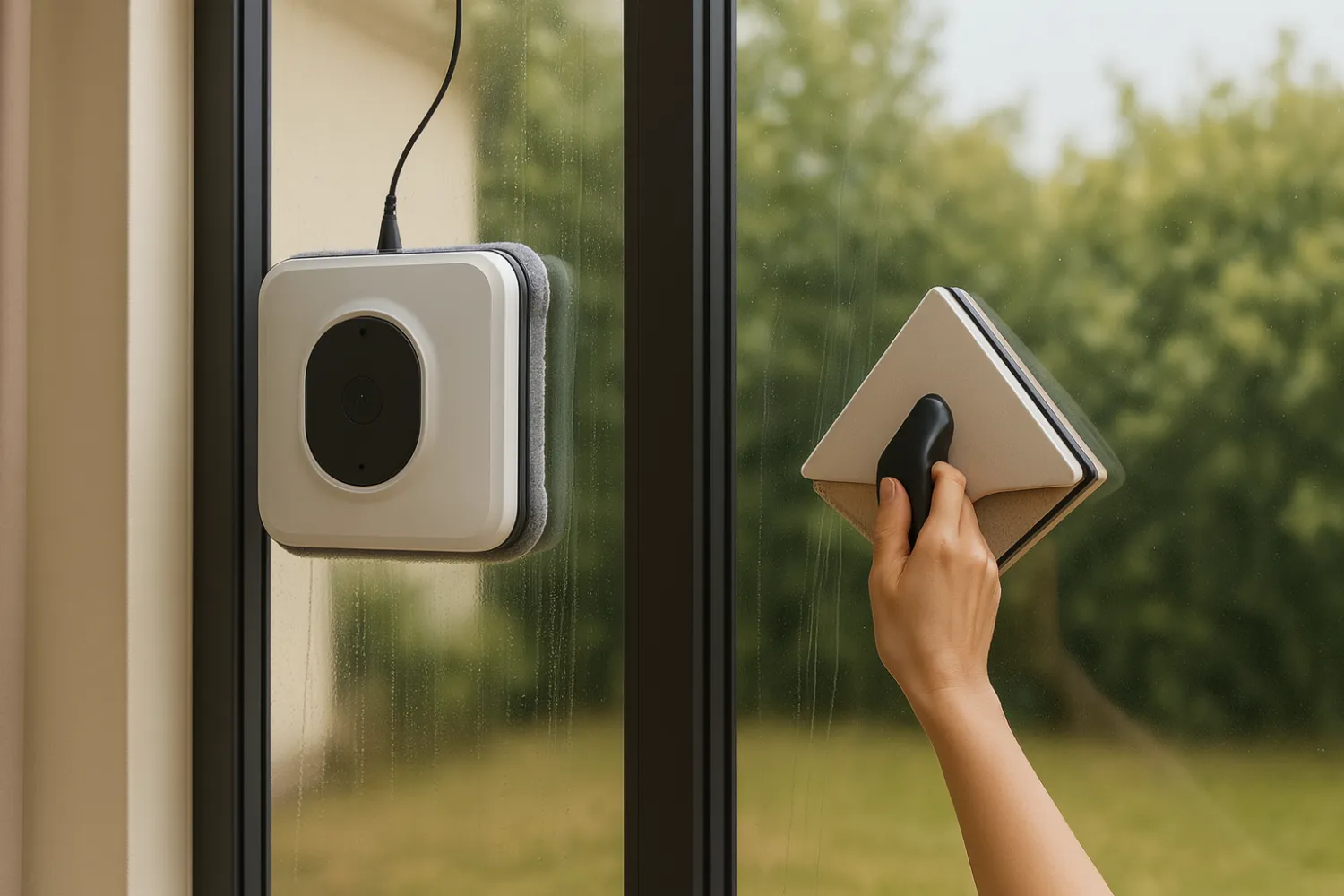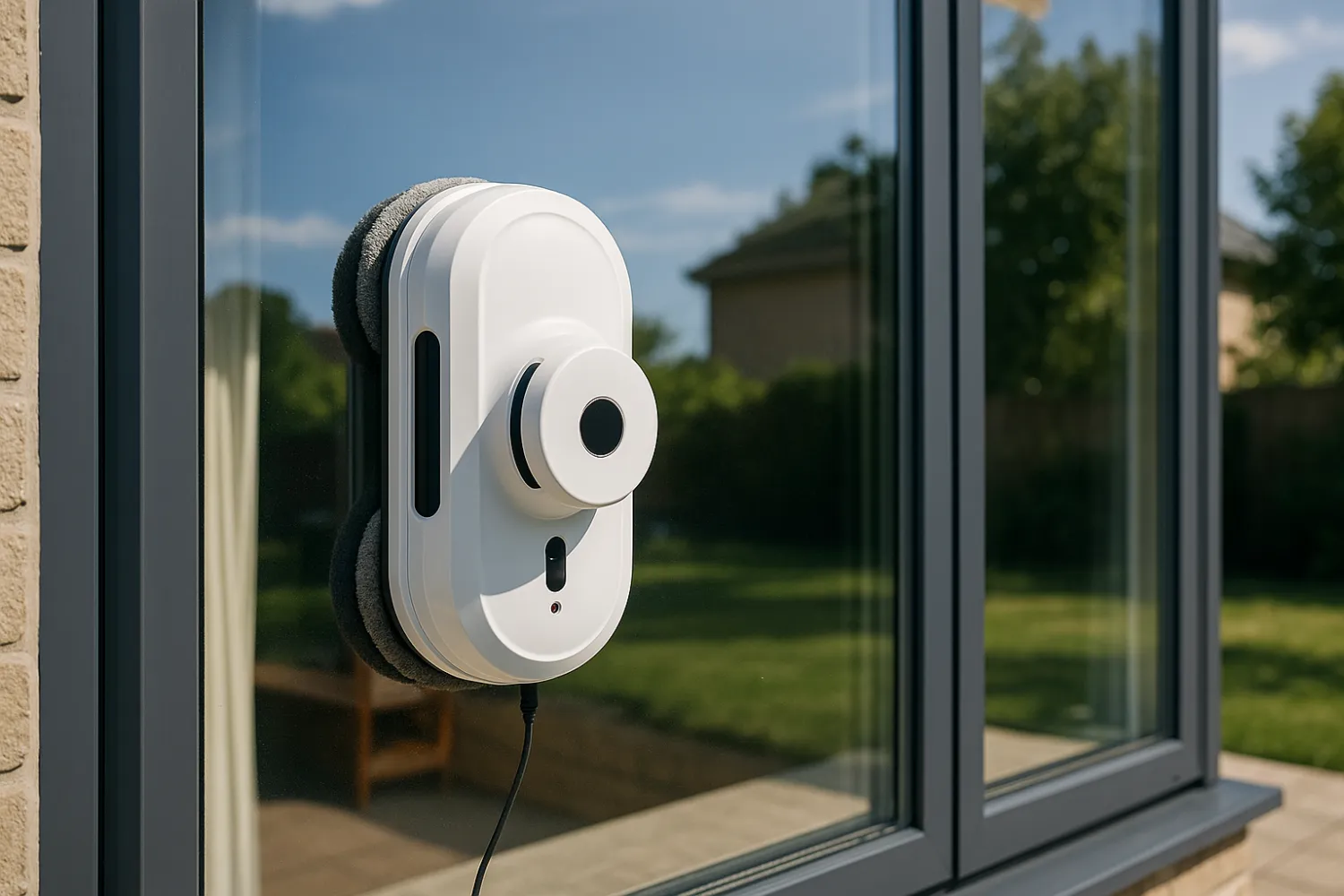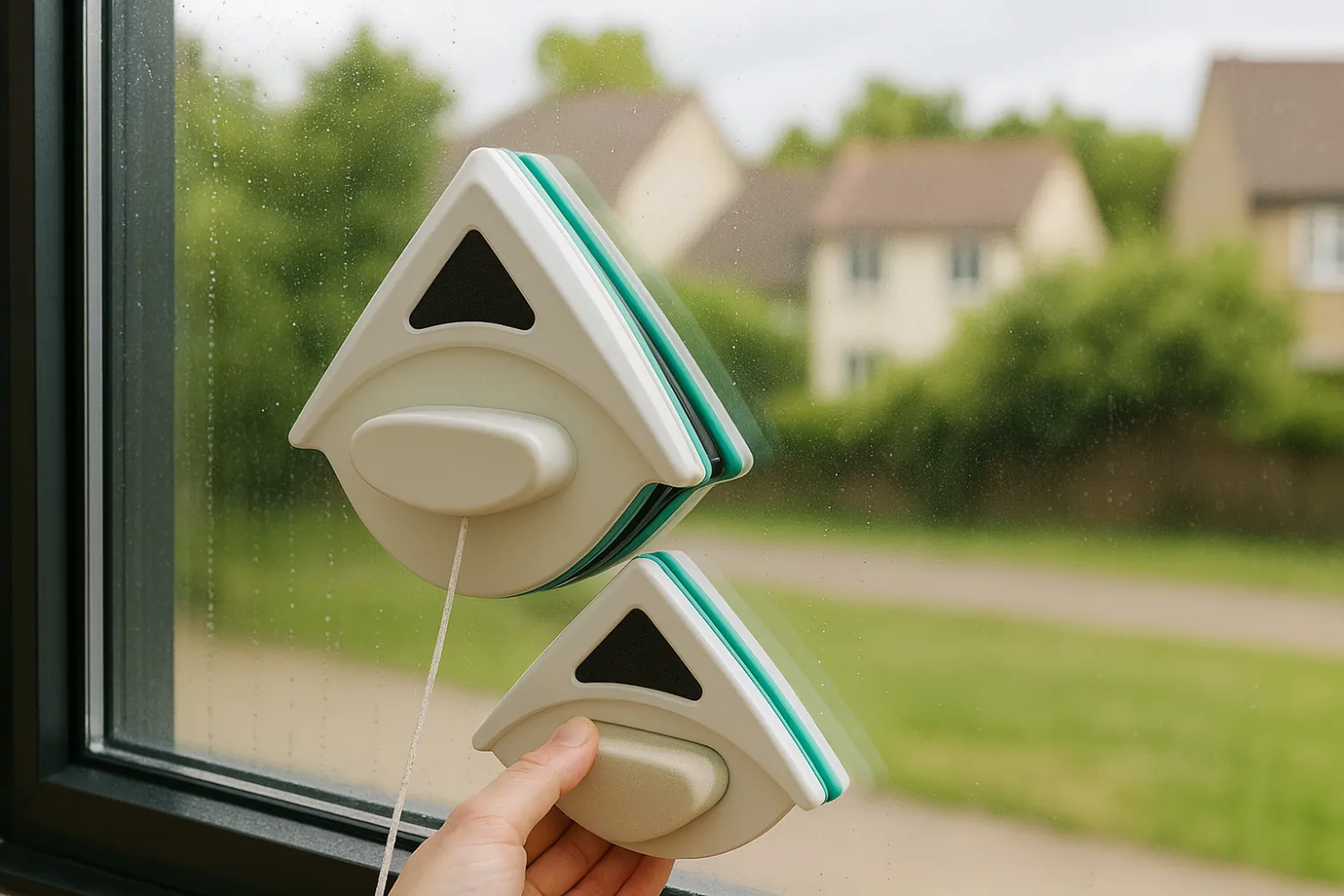
Table of Contents
When it comes to achieving sparkling, streak-free windows, the days of balancing precariously on a ladder with a bucket and squeegee are numbered. For most households in 2025, the robot window cleaner is the superior choice. It offers automated, safe, and consistent cleaning that a magnetic cleaner, despite its lower price, simply cannot match.
Magnetic cleaners are a clever, budget-friendly tool, but they demand significant manual effort, a tricky learning curve, and present a higher risk of failure. A Window Cleaner Robot, on the other hand, is an investment in convenience, safety, and a consistently better finish.
This guide will break down the key differences, pros, and cons of each device. Having worked on consumer tech marketing and product positioning for years, I’ve seen countless gadgets promise to make our lives easier. Here, we’ll cut through the hype to help you decide which window cleaning method is genuinely best for your home.
What Are Robot Window Cleaners?
Think of a robot window cleaner as a Roomba for your vertical surfaces. It’s a compact, intelligent device that uses powerful suction power to attach itself to your window. Once in place, it automatically navigates the glass, cleaning as it goes.

These robots use a combination of technologies. An internal vacuum motor creates a strong seal, while sophisticated sensors detect the edges of the window frame. They clean using rotating or vibrating microfibre pads, often paired with an automated spray system that applies cleaning solution. For safety, virtually all models come with a backup battery to prevent falls during a power cut and a strong safety tether as a final failsafe.
Pros of Robot Window Cleaners
- Unmatched Convenience: This is their biggest selling point. You place the robot on the window, press a button, and walk away. It does the work for you, saving you significant time and effort.
- Enhanced Safety: By automating the process, these robots eliminate the need to climb ladders or lean out of high-rise windows, drastically reducing the risk of accidents. The combination of anti-fall sensors, a backup battery, and a tether makes them incredibly secure.
- Consistent, Streak-Free Finish: The robot’s calculated path and consistent pressure on the microfibre pads result in a more uniform and often streak-free finish than you can achieve by hand.
- Versatility: Many modern robots are designed to work on various surfaces, including tiled walls, shower screens, and even frameless windows.
Cons of Robot Window Cleaners
- Higher Initial Cost: The technology comes at a price. A reliable robot window cleaner is a significant investment compared to manual alternatives.
- Power Dependent: Most models are mains-powered (with a long cord) to ensure consistent suction, meaning they need to be near a power socket.
- Corners and Edges: Due to their round or square shape, most robots can’t clean deep into the corners of a window pane.
- Heavy Grime: For windows that haven’t been cleaned in years, a robot may need a second pass or a manual pre-clean to achieve perfect results.
What Are Magnetic Window Cleaners?
A magnetic window cleaner is a much simpler, manual tool. It consists of two separate halves, each equipped with a cleaning pad and a strong magnet. You place one half on the inside of the window and the other on the outside. The magnets hold them together through the glass.

To use it, you manually slide the inner cleaner across the window. The powerful magnets force the outer half to follow its every move, cleaning both sides of the glass simultaneously. A safety string attached to the outer piece is meant to catch it if it falls.
Pros of Magnetic Window Cleaners
- Extremely Affordable: They are a fraction of the cost of a robot cleaner, making them a very accessible glass squeegee alternative.
- No Power Required: Being entirely manual, they can be used anywhere, anytime, without needing electricity.
- Lightweight and Simple: The design is straightforward, with no complex electronics or moving parts to worry about.
Cons of Magnetic Window Cleaners
- Difficult to Master: In my experience, this is the biggest issue. Moving the cleaner too fast can break the magnetic connection, while moving too slowly can leave a streaky mess. It takes a lot of practice to get a good result.
- Significant Safety Risk: If the outer half detaches—a common occurrence—it relies solely on a thin string to prevent it from falling. This is a huge risk for anyone living in a flat or a multi-storey house.
- Dependent on Glass Thickness: You must buy a model specifically rated for your window’s thickness (e.g., single, double, or triple glazing). A model for single glazing will be too weak for double glazing, and one for double glazing will be too strong for single glazing, risking damage.
- Physically Demanding: You are still doing all the work. It can be a real arm workout, which defeats the purpose for many people looking for an easier solution.
Head-to-Head Comparison: Robot vs Magnetic Cleaner
Let’s put these two contenders side-by-side to see how they stack up across the most important categories.
Cleaning Performance & Finish
A robot cleaner almost always delivers a better, more consistent finish. Its automated path ensures full coverage, and the microfibre pads are designed to buff the glass effectively.
A magnetic cleaner’s performance is entirely dependent on your skill. A common pitfall I see is users applying uneven pressure or using an incorrect S-shaped motion, which leads to frustrating streaks and smears. While a perfect finish is possible, it’s not guaranteed.
Winner: Robot Window Cleaner
Ease of Use & Convenience
There is no contest here. A robot is the definition of “set it and forget it.” A magnetic cleaner, by contrast, is fully manual and requires your full attention and physical effort from start to finish.
Winner: Robot Window Cleaner
Safety Features
This is a crucial differentiator. Robot cleaners are built with a multi-layered safety system: powerful suction power, backup power, anti-fall sensors, and a high-tensile safety tether.
The magnetic cleaner relies on a single, flimsy-looking string. The risk of the magnet detaching due to a sudden movement or an unseen obstacle on the window is very real. For anyone cleaning windows above the ground floor, the robot is indisputably the safer option.
Winner: Robot Window Cleaner
Cost & Value for Money
The magnetic cleaner is the clear winner on upfront cost. You can pick one up for as little as £20. Robot cleaners typically start around £150 and can go up to £500 or more.
However, from a value perspective, the robot wins for anyone who values their time and safety. The long-term convenience and peace of mind it provides can easily justify the initial investment.
Winner (Upfront Cost): Magnetic Cleaner
Winner (Long-Term Value): Robot Window Cleaner
Versatility (Window Types)
High-end robot cleaners are incredibly versatile. They can adapt to different glass thicknesses and many have edge-detection sensors that allow them to safely clean frameless windows and glass balustrades.
Magnetic cleaners are frustratingly specific. You must buy the correct model for your glass thickness, making them useless if you have a mix of single and double-glazed windows in your home.
Winner: Robot Window Cleaner
Who Should Buy a Robot Window Cleaner?
An investment in a robot window cleaner is a smart move for:
- Residents of flats or multi-storey homes where cleaning upper-floor windows is dangerous.
- Anyone with mobility issues or who finds physical chores difficult.
- Homeowners with large glass features like conservatories, bi-fold doors, or picture windows.
- Busy professionals and families who want to reclaim their time from weekend chores.
Who Should Buy a Magnetic Window Cleaner?
A magnetic cleaner is a suitable, budget-conscious choice for:
- People on a very tight budget.
- Those living in ground-floor properties where a falling outer half poses no danger.
- Individuals with standard, single-glazed windows who don’t mind the physical effort and have the patience to perfect the technique.
Verdict: which is better in 2025?
If you prioritise time savings, have tall or expansive panes, and want repeatable results, a robot window cleaner is the smarter choice. For budget‑conscious users with smaller or segmented windows – and those who prefer silent, simple tools – a magnetic cleaner remains highly effective.
Bottom line: choose robot for automation and large glass; choose magnetic for affordability, control and quiet use. Either way, clean pads, light solution, and proper safety are what deliver that crisp, streak‑free finish.
Frequently Asked Questions (FAQ)
Can robot window cleaners work on frameless windows?
Yes, many modern models are equipped with advanced sensors that can detect the edge of the glass, allowing them to clean frameless windows, glass doors, and balustrades safely without falling off. Always check the product specifications before buying.
How effective are robot cleaners on very dirty windows?
For windows with a thick layer of dirt and grime, a robot may struggle on its first pass. A common mistake is expecting a flawless finish in one go. For best results on very dirty glass, either run the robot through a second cycle with a fresh set of cleaning pads or give the window a quick manual wipe-down first.
Is the suction power of a robot cleaner safe for my windows?
Absolutely. The suction power is engineered to be strong enough to create a secure seal against the glass but is well within the safety tolerances of standard residential and commercial window panes. It will not crack or damage your windows.
What is the best window cleaning method overall?
The best window cleaning method depends on your priorities. For pure results, a professional window cleaner is unbeatable. But for balancing convenience, safety, and performance for home use, the robot window cleaner currently holds the top spot as the best all-around solution.






